How fast does bamboo grow?
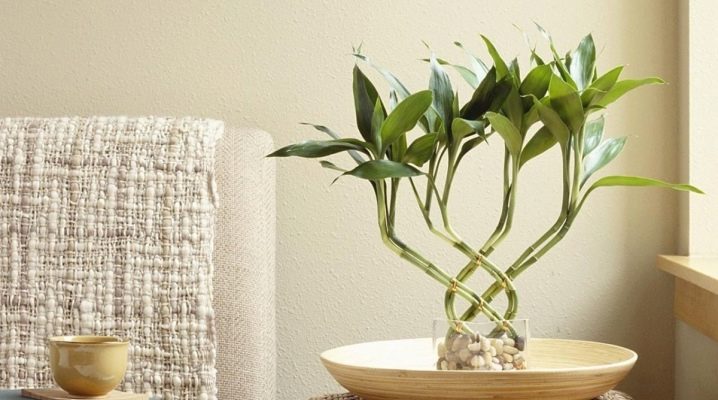
Bamboo is an outlandish plant that is more common in Asian countries. But today you can grow a unique culture at home. It is worth considering the key features of bamboo, as well as how to grow it in an apartment.

Growth rate per day
Bamboo is a plant that belongs to the group of cereals and represents a separate subfamily, where up to 50 genera and 1000 species of a similar crop are also represented... Each bamboo is different in shape and size, but they all share a lightweight and durable trunk. It is worth noting that in most countries, bamboo is prized solely for its trunk.
The plant is found mainly in tropical regions, where there is a high level of humidity and other optimal conditions for crop growth. In rare cases, bamboo can be found in the subtropics and even in temperate zones, and some species grow in the mountains. Today, varieties suitable for planting at home are also known.
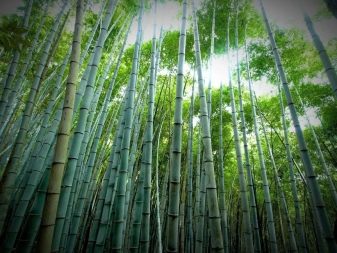
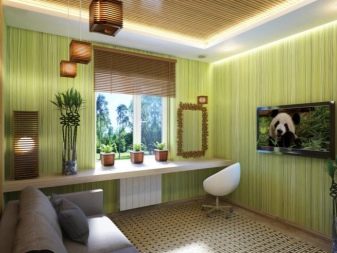
It is known that bamboo grows quite quickly. The longest member of the subfamily is the fast-growing dendrocalamus, which will grow by more than 40 centimeters per day. This property provides worldwide fame and demand. The plant is used for:
-
production of materials and tools;
-
cooking all kinds of dishes;
-
manufacturing of medicinal products.
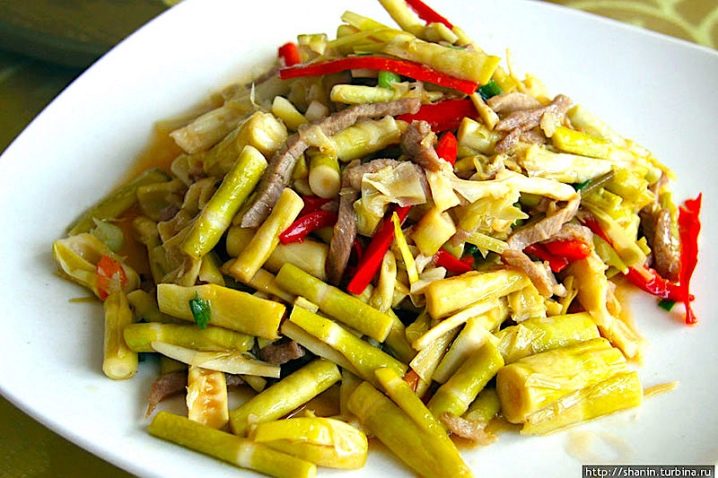
Also, bamboo is in demand in the furniture and construction industries. In some regions, residential and public buildings of high strength and stability are erected from long trunks that can last for many years.
Interestingly, in ancient times, bamboo was used to make bows that did not miss. Even today, the best bows in the world, as statistics show, are made of bamboo. And it is the growth of culture that makes it so popular, because in just a few months you can grow a large amount of material suitable for construction and other areas.
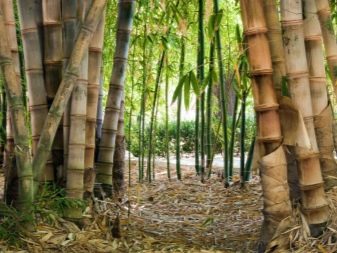
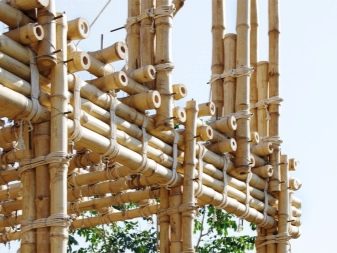
A couple more interesting facts about how bamboo was used in the past.
-
In Japan, they made nuku from it. - a special dish that involves young shoots cooked together. Rice flour was also used for cooking.
-
Bamboo seeds also went and are still used for food. Outwardly and in taste, they are somewhat similar to oats.
-
In China, a long time ago, calligraphy brushes were made from the trunks of culture. And the bark plates were used to write on it. Over time, paper was made from bamboo cellulose.
Bamboo fiber has a unique property - the ability to absorb moisture. Therefore, representatives of this culture, which literally in a couple of months overcome the bar of several meters, are today also used to make breathable clothing, stuffing pillows or blankets under which it is comfortable to sleep.

Plant development cycle
Anyone who has seen the bamboo thickets will note that the sight is unforgettable. As already mentioned, the longest representatives of the species are the dendrocalamus varieties, the stems of which are capable of building real woody cities.
It is interesting that if you stop in the forest for a few hours and watch the bamboo thickets, you will notice how the stems of a unique culture stretch upward. No other plant can provide a similar spectacle. Bamboo emerges from the ground in the form of a miniature shoot. However, with age, the trunks of the plant grow stronger, and it begins to stretch upward. Usually a culture takes 5 years to reach a medium size.
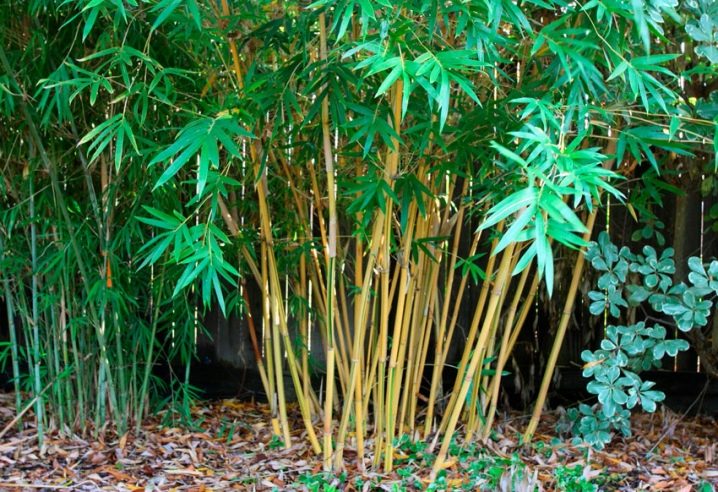
The cycle of plant development is as follows.
-
First of all, the plant begins to form roots. Therefore, at first, bamboo grows slowly, because it is important for it to establish the extraction of nutrients and moisture from the ground. At this stage, the culture does not grow up for a long time.
-
Further, the plant actively picks up speed and starts up unrestrained growth, along the way forming an innumerable number of lateral branches - shoots. Usually this stage lasts for 10 years, during which the bamboo has time to gain in growth.
-
The third stage is flowering... Visibly grown specimens begin to form large buds. If the species has bloomed, then it is about 20-30 years old.
-
Culture after flowering gradually dies offstopping its growth.
It should be noted that the last stage is typical only for the green and aboveground parts. The roots of the plant continue to live. And if you do not allow the culture to bloom, then it will turn out to extend the life of the plant, since it will not spend energy on supporting the buds.
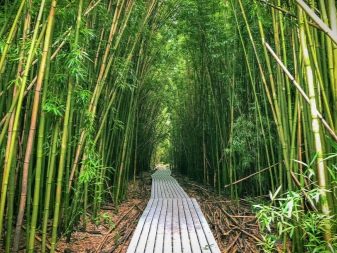
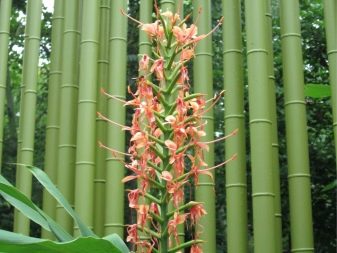
Does bamboo grow at home?
Many gardeners are interested in the question of whether it is possible to grow bamboo at home, albeit a small one. This is quite possible if you buy a variety of indoor bamboo, which, it is worth noting, has practically nothing to do with a wild plant. The culture received its name only due to its external resemblance to the species that is found in the wild. Plus "home" varieties in easy care. Among the characteristics of a compact plant, bright green stems are distinguished, at the end of which new shoots of various shapes are regularly formed.
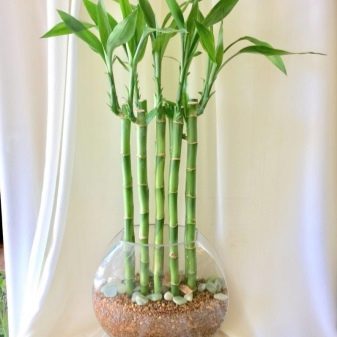
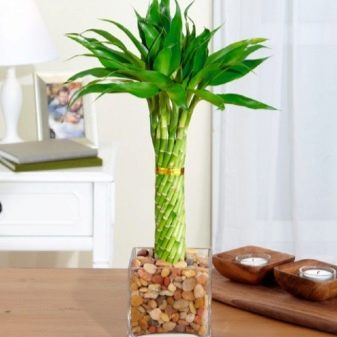
Conditions for growing a culture.
-
For compact bamboo, light is important. An exotic plant will tend upward only in diffused lighting. Otherwise, the culture will quickly rot, the leaves will turn yellow, and the plant will lose all its attractiveness.
-
At home, bamboo grows more slowly than it does in the wild. However, the culture can still rise from the ground to an impressive distance in a fairly short time, if you take care of the optimal ratio of moisture and light.
-
Bamboo plant leaves are recommended wipe regularly with a damp cloth so that they do not dry out.
-
For the correct formation of the plant, you should take care of pruning the shoots.... Only in this case it will be possible to increase the growth rate. For pruning, it is better to use scissors or pruning shears, which are recommended to be selected depending on your own preferences. To prevent the development of diseases, the cut sites are recommended to be waxed.
The cut stems can be used to propagate the crop by replanting them in new pots. If the bamboo has practically ceased to release shoots, it is worth pinning the upper edge, and then the plant will restore its previous development.

If you follow the rules of planting and care, then bamboo will grow intensively and delight others with its attractive green appearance.
And if with leaving everything is more or less clear, then it is worth dwelling on the features of planting a plant in more detail.
Basic moments.
-
Bamboo is not picky about the soil, but for active growth it is better to plant the plant in fertile soil. At the same time, a culture transplant should be carried out every spring so that the root system can develop.
-
When choosing a pot for a bamboo culture, you should give preference to wide and voluminous containers. It is important that a distance of 5 cm or more is maintained between the walls of the pot and the roots.
-
There should be holes at the bottom of the pot - a drainage system that will remove excess water and prevent root rot. The optimal drainage layer should be 3 cm.

To water the bamboo after planting, use warm water, which must first be defended. Additionally, flower growers recommend paying attention to the size of the roots.If necessary, if they are too long, they will need to be trimmed.
To plant bamboo, first use a transparent vase filled with water, where a small sprout is placed. It is better to give preference to transparent containers to make it easier to monitor the water quality and the condition of the root system.
Aquatic cultivation of sprouts promotes active growth and color saturation. Therefore, before transplanting into a pot, the culture will acquire a bright green color and will noticeably expand. As it grows, the bamboo will start to release flowers. This usually happens every 30 years, so the phenomenon is quite rare.
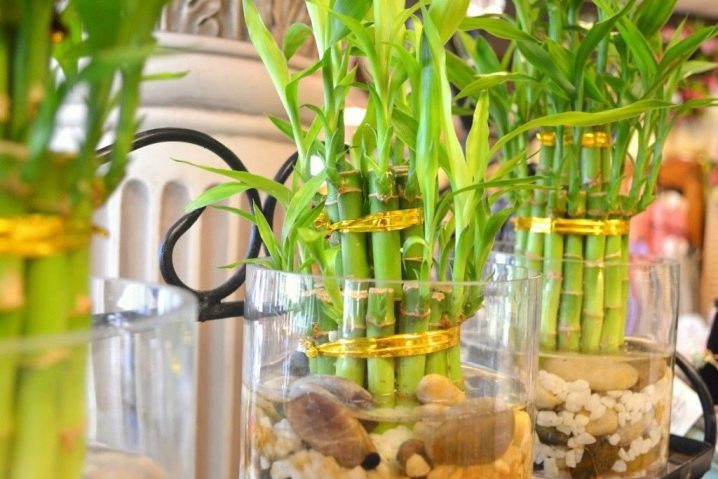



























The comment was sent successfully.